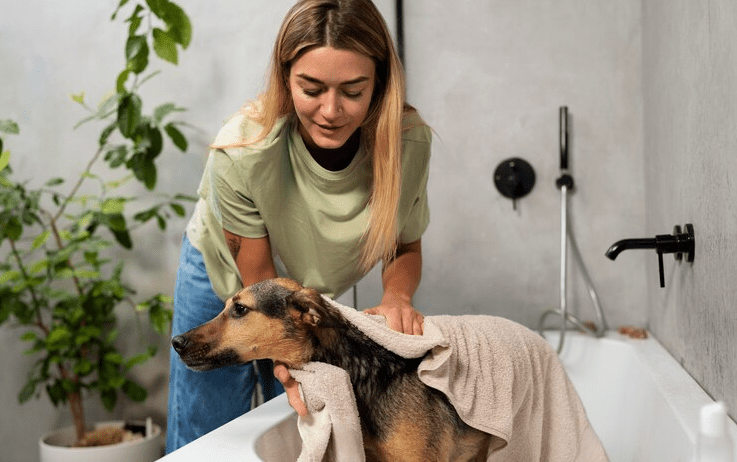Exploring the fascinating connection between pet grooming and agriculture reveals some surprising similarities. From cultivating natural ingredients for grooming products to implementing sustainable practices in pet care, agriculture plays a hidden yet vital role in keeping our furry friends looking and feeling their best. Dive deeper into the world of pet grooming and discover how it intertwines with the vast realm of agriculture, uncovering unexpected insights and connections along the way.
Historical Connection between Animal Care and Farming
Farmers have historically relied on animals for labor, transportation, and companionship, necessitating comprehensive animal care practices. Ancient civilizations developed early veterinary practices to maintain the health of livestock, ensuring productivity and survival. By domesticating animals for farming, advancements in breeding, feeding, and medical care techniques emerged. Historical records show that successful farming communities prioritized animal welfare, recognizing its impact on agricultural efficiency and sustainability. Through these practices, the bond between humans and animals has been integral to the evolution of farming, illustrating a timeless connection between animal care and agricultural prosperity.
Early Practices of Animal Husbandry
Early practices of animal husbandry transformed wild animals into reliable sources of food and labor, providing a foundation for agricultural success. Ancient civilizations, recognizing the benefits, engaged in selective breeding to enhance traits like strength and milk production in their livestock. Meanwhile, pastoral societies perfected nomadic herding techniques, skillfully moving large herds across expansive landscapes. By integrating livestock management with crop farming, early agricultural communities created sustainable systems for food production and soil fertilization. These foundational practices not only ensured survival but also laid the groundwork for modern agriculture.
Evolution of Grooming Techniques in Agricultural Settings
Early agricultural grooming techniques relied heavily on manual labor and rudimentary tools, reflecting the limited technology of the time. However, the mid-20th century saw a revolution in livestock grooming with the introduction of mechanical shears and automated grooming machines, boosting efficiency and easing the physical burden on farmers. Today, modern advancements in biotechnology and precision agriculture have given rise to specialized grooming equipment tailored to the unique needs of various animal breeds. Moreover, integrating data analytics and smart technology into grooming practices enables the monitoring of animal health and the optimization of grooming schedules, thereby enhancing welfare and productivity.
Economic Impact of Pet Grooming in Rural Communities
Pet grooming businesses in rural communities can generate significant local revenue and create job opportunities for residents, fostering economic growth. With local grooming services available, pet owners save on travel expenses they would otherwise incur visiting urban centers. This investment often spurs the growth of related sectors such as pet supplies, veterinary services, and pet boarding, further boosting the local economy.

Moreover, enhanced grooming services contribute to the overall health and well-being of pets, ultimately reducing veterinary costs and promoting a healthier community.
Job Creation and Local Business Growth
Job creation stimulates economic development and reduces unemployment rates in local communities, acting as a catalyst for prosperity. Local business growth fosters a stronger economy by keeping money circulating within the community, ensuring a robust financial ecosystem. Expanding local businesses can lead to increased demand for local suppliers and services, further boosting the local economy. Investing in job creation and supporting local businesses can enhance community resilience and promote sustainable development, creating a virtuous cycle of growth and stability.
Synergies with Agricultural Markets
Collaborative efforts between agricultural producers and markets can lead to increased efficiency and profitability. Leveraging technological advancements enhances the transparency and traceability of agricultural products, ensuring that consumers are well-informed about their food sources. Integrating sustainable farming practices with market demands drives growth and yields significant environmental benefits. Building strong relationships between farmers and market stakeholders fosters innovation and resilience in the agricultural sector, creating a robust ecosystem that can adapt to changing conditions and continue to thrive.
Shared Skills and Knowledge between Farmers and Pet Groomers
Farmers and pet groomers share a profound understanding of animal behavior, which is crucial for managing stress and preventing injuries. Both professions require an in-depth knowledge of proper nutrition and diet to ensure the health and well-being of animals under their care. Skilled use of various tools and equipment specific to animal care and grooming is another commonality, highlighting the technical expertise needed in both fields. Additionally, experience in identifying and treating common health issues is essential, as it ensures the maintenance of animal welfare and promotes a high standard of care.
Animal Behavior Understanding
Understanding animal behavior is crucial for effective training and care, as it allows handlers to tailor their approaches to each animal’s unique needs. Recognizing the signs of stress or discomfort in animals can prevent potential health issues, ensuring their well-being and longevity. This knowledge aids in creating a safe and enriching environment for pets, where they can thrive and feel secure. Moreover, studying animal behavior helps build stronger bonds between pets and their owners, fostering a relationship based on trust and mutual understanding. By delving into the intricacies of how animals think and act, caretakers can enhance the quality of life for their furry companions.
Use of Tools and Equipment
Regularly maintaining grooming tools such as brushes, clippers, and combs ensures their longevity and effectiveness, ultimately making your grooming routine smoother. Choosing the right tools for your pet’s specific coat type can significantly enhance the grooming experience, ensuring both comfort and efficiency. Sanitizing grooming equipment after each use is essential to prevent the spread of infections and maintain hygiene, safeguarding your pet’s health. Moreover, investing in high-quality grooming tools can save money in the long run by reducing the frequency of replacements and improving grooming results, offering a more economical and effective solution for pet care.
Health Benefits for Farm Animals through Grooming
Regular grooming plays a pivotal role in maintaining healthy skin and coats in farm animals, significantly reducing the risk of infections and parasites. Not only do these grooming sessions allow for the early detection of health issues such as cuts, lumps, or skin conditions, but they also ensure timely veterinary intervention. The benefits extend further, as consistent grooming improves blood circulation and can alleviate stress, contributing to the animals’ overall well-being. Additionally, proper grooming practices prevent hoof problems and other mobility issues, ensuring that farm animals remain active and productive. Through these comprehensive grooming routines, farm animals can enjoy enhanced health and vitality.
Preventative Health Measures
Regular veterinary check-ups are crucial for the early detection of potential health issues, ensuring that any problems can be addressed promptly. Maintaining a balanced diet and a consistent exercise routine helps prevent obesity and related health problems, contributing to your pet’s overall well-being. Administering vaccinations and parasite control treatments protects your pet from common diseases, safeguarding their health. Additionally, dental care, including regular brushing and professional cleanings, is essential to prevent oral health issues, ensuring your pet’s mouth remains healthy and pain-free. By adhering to these preventative measures, you can significantly enhance your pet’s quality of life.
Enhanced Productivity and Longevity
Regular pet grooming is essential for maintaining a clean coat, which significantly enhances a pet’s overall productivity and well-being. By reducing the risk of skin infections and parasites, grooming directly contributes to a pet’s longevity. Additionally, routine grooming sessions enable early detection of health issues, ensuring timely veterinary intervention. Proper grooming practices, such as nail trimming and ear cleaning, not only prevent discomfort but also promote an active lifestyle for pets. Through these comprehensive grooming routines, pets can enjoy better health and a higher quality of life.
Sustainability and Environmental Considerations
Incorporating eco-friendly materials in pet grooming products significantly reduces environmental impact, making sustainability a priority. Sustainable grooming practices, such as using biodegradable shampoos and conditioners, are not only kind to pets but also to the planet. Additionally, minimizing water waste during grooming sessions helps conserve this precious resource, aligning with broader environmental goals. Employing energy-efficient grooming tools and equipment further lowers carbon footprints, ensuring that pet care remains responsible and environmentally conscious. Through these mindful choices, pet owners contribute to a healthier planet while keeping their furry friends well-groomed and happy.
Waste Management and Recycling Practices
Implementing effective waste segregation at the source can significantly improve recycling rates, ensuring that materials are appropriately processed and reused. By educating communities about the environmental benefits of recycling, more sustainable practices can be fostered, leading to a collective effort in waste reduction. Adopting advanced technologies for waste processing further minimizes landfill usage and curbs pollution, creating a cleaner environment. Moreover, promoting the use of recyclable and biodegradable materials plays a crucial role in reducing the overall waste footprint, contributing to a more sustainable future for all.
Eco-Friendly Products Used in Both Fields
Eco-friendly pet grooming products often include natural shampoos, conditioners, and sprays that are free from harmful chemicals and artificial fragrances, ensuring a safer grooming experience for pets. Biodegradable grooming tools, such as bamboo brushes and combs, help reduce environmental impact while maintaining pet hygiene. Additionally, using organic and sustainably-sourced ingredients in grooming products provides benefits not only for the environment but also for pets’ health and well-being. Furthermore, recyclable and minimalistic packaging for these products helps decrease waste and promote a greener planet, making sustainable pet care both practical and responsible.
Conclusion
In conclusion, pet grooming and agriculture exhibit a profound and multifaceted relationship that underscores the interconnectedness of animal care and farming. Historically, the meticulous care of farm animals was essential for agricultural productivity and sustainability, laying the foundation for modern grooming practices. The evolution of grooming techniques, from manual labor to advanced technology, reflects the agricultural sector’s continual adaptation and innovation.
Economically, pet grooming businesses in rural areas not only boost local economies but also enhance community well-being by providing essential services and creating job opportunities. These synergies extend to agricultural markets, where collaborative efforts between farmers and groomers contribute to efficiency and profitability.
Furthermore, the shared skills and knowledge between farmers and pet groomers highlight the importance of understanding animal behavior, proper nutrition, and the use of specialized tools. Such expertise ensures the health and longevity of animals, whether they are pets or livestock, ultimately benefiting both fields.
Health benefits derived from regular grooming, including the prevention of infections and early detection of health issues, underscore the critical role of grooming in maintaining animal welfare. Sustainable practices and the use of eco-friendly products further demonstrate a commitment to environmental stewardship, ensuring that animal care remains responsible and conscious of broader ecological impacts.
In essence, the art of grooming transcends mere aesthetics, embodying a holistic approach to animal care that is deeply rooted in agricultural traditions. By fostering a culture of comprehensive care and sustainability, both pet groomers and farmers contribute to a thriving, resilient community that values the well-being of its animals and the environment.















